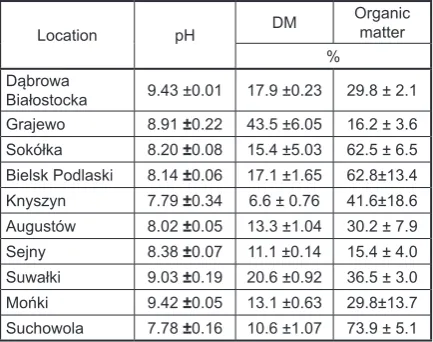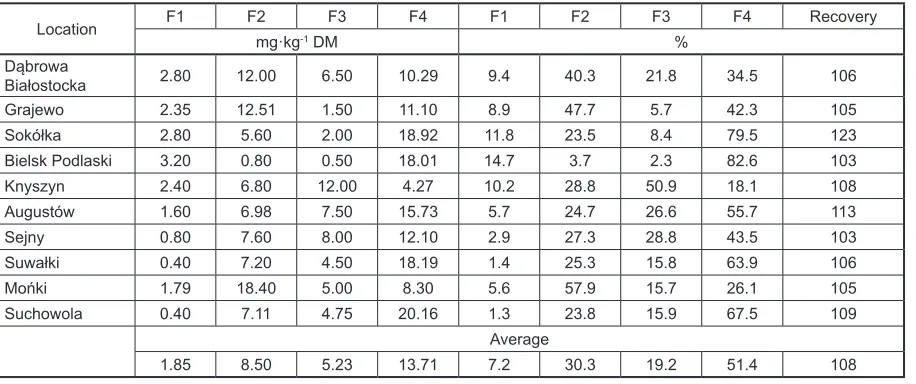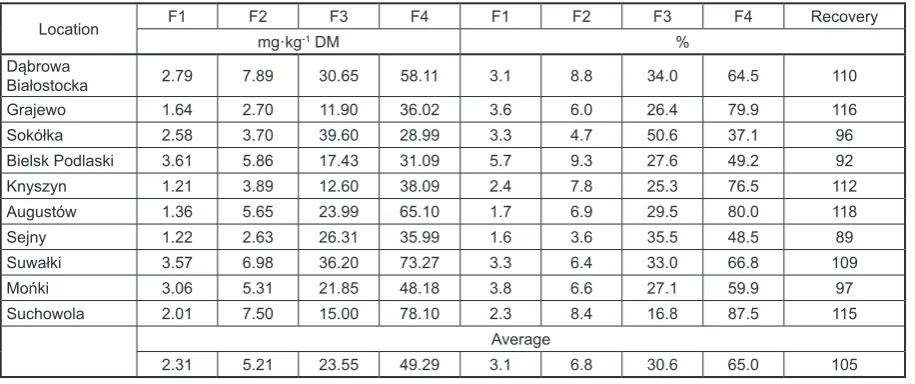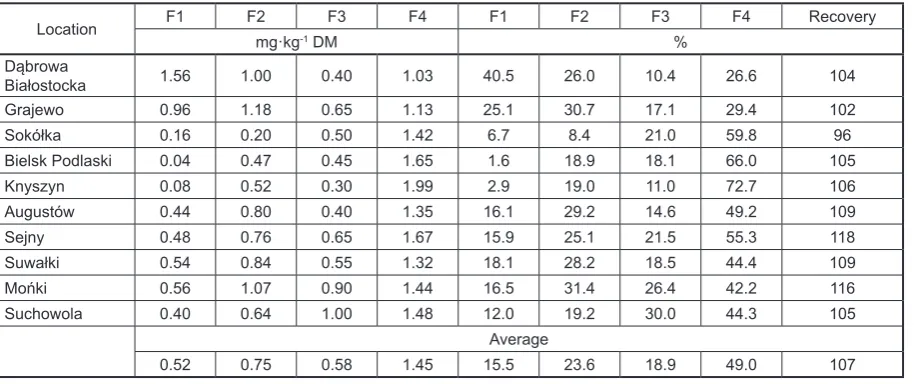INTRODUCTION
The utilisation of sewage sludges is nowa-days one of the most important problems in sew-age mansew-agement of cities in majority of European countries. The amount of the produced municipal sewage sludge is systematically increasing [Wilk, Gworek 2009]. Better utilisation of biogenic sub-stances from sludges is planned, keeping all the regulations related to sanitary and chemical safe-ty [Bień, Wystalska 2008].
The use of municipal sewage sludge in ag-riculture according to regulations is a current problem. The biggest threat is connected with heavy metals, which contained therein. Once in-troduced into natural environment, heavy met-als remain therein as they are not biodegradable. These metals can be cumulated by plants and thus create potential negative effect on animals and human health.
Lead and cadmium belong to a group of tox-ic elements for plants [Łukowski, Wiater 2011].
Chromium was never recognised as an essen-tial element for plant growth, but some of its stimulating effects were reported [Sanghamitra et al. 1998]. These metals accumulate mainly in kidneys, the adrenal gland, liver, lungs, hair and skin, and they may cause high blood pres-sure, cancerous changes, damage to kidneys, liver and brain. In some cases they may also lead to mental disorders and loss of brain function [Szyczewski et al. 2009].
The total content of heavy metals in sewage sludge does not provide information about their availability for plants and thus about the amount of element, which will be introduced into biologi-cal cycle. The percentage of metals in mobile, or potentially mobile form available for plants, can be estimated using sequential extraction [Shrivas -tava, Banerjee 2004; Szumska, Gworek 2009; Rao et al. 2008]. The most often sequential extraction procedures involve extraction of metals from the following fractions: exchangeable, bound with carbonates, bound with Fe/Mn oxides, bound
FRACTIONATION OF HEAVY METALS (Pb, Cr AND Cd) IN MUNICIPAL
SEWAGE SLUGES FROM PODLASIE PROVINCE
Adam Łukowski1
1 Department of Technology in Engineering and Environment Protection, Faculty of Civil and Environmental
Engineering, Bialystok University of Technology, 15-351 Białystok, Wiejska 45A, Poland, e-mail: a.lukowski@pb.edu.pl
Volume 18, Issue 1, Jan. 2017, pages 132–138
DOI: 10.12911/22998993/66244 Research Article
ABSTRACT
In the samples of fresh dehydrated sewage sludges from municipal treatment plants in Grajewo, Bielsk Podlaski, Sokółka, Dąbrowa Białostocka, Knyszyn, Mońki, Au -gustów, Suwałki, Sejny and Suchowola the following determinations were made: pH, pseudo-total content of Pb, Cd and Cr, organic matter and dry mass. The con-tents of the above-mentioned elements in fractions were evaluated using modified BCR method (four fractions: 1-acid soluble and exchangeable, 2-reducible, 3-oxi -dizable, 4-residual). The lead content (mean values) in particular fractions can be arranged quantitatively in a sequence: F4 (51.4%) > F2 (30.3%) > F3 (19.2%) > F1 (7.2%), in the case of cadmium: F4 (49.0%) > F2 (23.6%) > F3 (18.9%) > F1 (15.5%) and in the case of chromium: F4 (65.0%) > F3 (30.6%) > F2 (6.8%) > F1 (3.1%). Cumulative content of lead in mobile fractions (F1+F2+F3) ranged from 20.7% to 89.9%; for cadmium from 32.9% to 76.9% and for chromium from 27.5 to 58.6% of pseudo-total content.
Keywords: lead, cadmium, chromium,metal fractions, sewage sludge
Table 1. Physico-chemical characteristics of sewage sludges (mean ± SD, n=3)
Location pH DM
Organic matter %
Dąbrowa
Białostocka 9.43 ±0.01 17.9 ±0.23 29.8 ± 2.1 Grajewo 8.91 ±0.22 43.5 ±6.05 16.2 ± 3.6
Sokółka 8.20 ±0.08 15.4 ±5.03 62.5 ± 6.5
Bielsk Podlaski 8.14 ±0.06 17.1 ±1.65 62.8±13.4
Knyszyn 7.79 ±0.34 6.6 ± 0.76 41.6±18.6
Augustów 8.02 ±0.05 13.3 ±1.04 30.2 ± 7.9 Sejny 8.38 ±0.07 11.1 ±0.14 15.4 ± 4.0
Suwałki 9.03 ±0.19 20.6 ±0.92 36.5 ± 3.0
Mońki 9.42 ±0.05 13.1 ±0.63 29.8±13.7
Suchowola 7.78 ±0.16 10.6 ±1.07 73.9 ± 5.1 with organic matter and residual (metals associ
-ated with crystal lattice of minerals).
Investigation of fractional composition of metals in municipal sewage sludges is important in particular when they will be applied into light and acidic soils with low content of potassium, phosphorus as well as magnesium, and such a soils occur mainly in Podlasie Provice. That is because the above-mentioned factors of soil qual-ity can influence the movement of heavy metals [Wiater, Łukowski 2010].
EXPERIMENTAL PROCEDURES
The study was based on fresh dehydrat-ed sewage sludges collectdehydrat-ed in the year 2010. They came from municipal treatment plants in Grajewo, Bielsk Podlaski, Sokółka, Dąbrowa Białostocka, Knyszyn, Mońki, Augustów, Suwałki, Sejny and Suchowola. The sludges were hygenized (mainly with burnt lime), except these from Sokółka, Augustów and Suchowola. The fractionation was made in average samples (three individual dried samples were mixed and homogenized). In collected samples the follow -ing determinations were made: pH potentiomet-rically, dry mass by drying at 105 ºC, organic matter by heating in oven at 600 ºC until a con -stant weight was achieved, pseudo-total content of Pb, Cr, Cd (after previous digestion in HNO3 with 30% H2O2) by means of FAAS technique and content of studied metals in fractions by means of GFAAS technique using Varian AA-100 apparatus. The percentage of individual fractions in pseudo-total content of each element was calculated. Recovery was defined as a ratio of metal content in four fractions (F1, F2, F3 and F4) to the pseudo-total content.
Modified BCR method with a use of ultrason -ic probe Son-ics VCX 130 was used to evaluate fractional composition of Pb, Cd and Crin sludge samples.Extraction included four stages:
1. Acid soluble and exchangeable fraction (F1) – 1 g of sludge in 100 cm3 centrifuge tube
with 40 cm3 of 0.11 mol·dm-3 acetic acid was
sonicated for 7 minutes (power – 20W) at temperature 22±5 ºC. Then, the mixture was centrifuged for 20 minutes at 3000 g. The ex-tract was separated for analysis. Residue with 20 cm3 of deionized water was sonicated for 5
minutes (power – 20W) and centrifuged for 20 minutues at 3000 g. Water was discarded.
2. Reducible fraction, bound to Fe/Mn oxides (F2) – to the residue from the first step was added 40 cm3 of 0.5 mol·dm-3 hydroxylamine
hydro-chloride fresh solution, pH 1.5, and sonicated for 7 minutes (power – 20W) at temperature 22±5 ºC. Then, the mixture was centrifuged for 20 minutes at 3000 g. The extract was sepa-rated for analysis. The residue was rinsed with deionized water, alike in the first step.
3. Oxidizable fraction, bound to organic matter (F3) – to the residue from the second step was added 20 cm3 of 30% hydrogen peroxide and
sonicated for 2 minutes (power – 20W) at tem -perature 22±5 ºC. Then, the volume of H2O2 reduced to approx. 1 cm3 using water bath. 50
cm3 of 1 mol·dm-3 ammonium acetate and
soni-cated for 6 min. (power – 20W) at temperature 22±5 ºC was added to the moist residue. Then, the mixture was centrifuged for 20 minutes at 3000g. The extract was separated for analysis. The residue was rinsed with deionized water, alike in the previous steps.
4. Residual fraction (F4) – the residue from the third step was extracted using concentrated HNO3 with addition of 30% H2O2.
RESULTS AND DISCUSSION
com-pounds or low molecule organic matter. The re-action is the main factor, which influences the solubility of metal compounds in environment [Wilk, Gworek 2009].
The content of dry mass ranged from 6.6 to 43.5%. The lime-treated sludges contained the highest amounts of dry matter, in general.
The sludges contained from 15.4 to 73.9% DM of organic matter. According to Mazur [Ma -zur 1995], the content of organic matter in sewage sludge rage from 17 to 87% (60% on average). It has the ability to form stabile complexes, which appreciably can decrease the mobility of metals. The biggest affinity to organic matter have ele -ments such as Ni, Cu and Pb [Karczewska 2002]. The pseudo-total amounts of studied elements were below values intended for agricultural use of sludge (Table 2). As stated by Maćkowiak [2000], the average content of cadmium in municipal sludges is 3.3 mg·kg-1 DM. In 40% of studied
sludges the Cd content was higher. The content of lead and chromium in all samples was lower, than the average (92 and 175 mg·kg-1 DM respec
-tively) reported by above-mentioned author. The content of metals in particular fractions, in general, was differentiated. It’s related to var -ied sources and initial form of metals in sewage sludges, their pH, conductivity, content of organic matter and redox properties [Wilk, Gworek 2009].
Lead
The highest amount of lead (51.4% on aver -age) was bound to residual fraction and ranged from 26.1 to 82.6% (Table 3). According to Pi -otrowska and Dudka [1987] considerable dif
-ferentiation of metal content in this fraction is dependent on source of sewage sludge. The results of other authors’ studies confirm a high content of Pb in residual fraction [Wang et al. 2008; Fuentes et al. 2004; García-Delgado et al. 2007], which is unavailable for plants. The con -tent of metals in this fraction is almost constant (changes can occur, to a small degree, only in extreme acid environment or due to the microor-ganisms’ activity).
The results of the study have proved slight solubility and thus bioavailability of lead in sew-age sludges, because only 7.2% of pseudo-total Pb content was noted in fraction F1. Metals bound to this fraction can be easily released after appli-cation of sludge into soil, due to the small bond strength [Wang et al. 2008, Kazi et al. 2005], dur -ing fractionation of sludges from the treatment plant located in Hyderabad city (Pakistan), with BCR method,have noted 4% of pseudo-total lead Table 2. Pseudo-total content of Pb, Cr and Cd in sewage sludges (mean ± SD, n=3)
Location Pb Cr Cd
mg·kg-1 DM
Dąbrowa
Białostocka 29.80 ± 0.77 90.10 ± 2.44 3.85 ± 0.14 Grajewo 26.24 ± 1.54 45.11 ± 3.56 3.83 ± 0.25
Sokółka 23.80 ± 1.39 78.20 ± 1.22 2.38 ± 0.10
Bielsk Podlaski 21.80 ± 0.77 63.23 ± 3.14 2.49 ± 0.23
Knyszyn 23.58 ± 0.77 49.82 ± 0.82 2.74 ± 0.00
Augustów 28.25 ± 1.02 81.34 ± 8.80 2.74 ± 0.13 Sejny 27.80 ± 2.14 74.20 ± 3.82 3.02 ± 0.20
Suwałki 28.47 ± 1.93 109.69 ± 25.81 2.98 ± 0.20
Mońki 31.81 ± 1.02 80.47 ± 1.91 3.40 ± 0.13
Suchowola 29.85 ± 0.43 89.23 ± 1.94 3.34 ± 0.07
Table 3. Content, percentage in fractions and recovery of Pb in the sewage sludges
Location F1 F2 F3 F4 F1 F2 F3 F4 Recovery
mg·kg-1 DM %
Dąbrowa
Białostocka 2.80 12.00 6.50 10.29 9.4 40.3 21.8 34.5 106
Grajewo 2.35 12.51 1.50 11.10 8.9 47.7 5.7 42.3 105
Sokółka 2.80 5.60 2.00 18.92 11.8 23.5 8.4 79.5 123
Bielsk Podlaski 3.20 0.80 0.50 18.01 14.7 3.7 2.3 82.6 103
Knyszyn 2.40 6.80 12.00 4.27 10.2 28.8 50.9 18.1 108
Augustów 1.60 6.98 7.50 15.73 5.7 24.7 26.6 55.7 113
Sejny 0.80 7.60 8.00 12.10 2.9 27.3 28.8 43.5 103
Suwałki 0.40 7.20 4.50 18.19 1.4 25.3 15.8 63.9 106
Mońki 1.79 18.40 5.00 8.30 5.6 57.9 15.7 26.1 105
Suchowola 0.40 7.11 4.75 20.16 1.3 23.8 15.9 67.5 109
Average
content in fraction mentioned before.Wang et al. [2008]obtained similar result, below 5% of Pb as compared to total content, in acid soluble and ex-changeable fraction of sewage sludge from plant in Loujiang (China).
The average lead content in F2 fraction con-stituted 30.3% of pseudo-total content.This frac-tion is thermodynamically unstable. Anaerobic conditions and microorganisms’ activity in slud -ges are leading to reduction and disintegration of Fe/Mn oxides, what can cause metal desorption [Jamali et al. 2007]. These factors may have influ -enced the content of Pb in above-mentioned frac-tion of sludge came from Bielsk Podlaski, which was very low. Fuentes at al. [2004] have stated in the reducible fraction of non-stabilized sewage sludge 20.7% of total lead.
The oxidizable fraction bound 19.2% of pseudo-total Pb content on average. Accord -ing to Wang et al. [2006] this fraction dominate in sewage sludge, in the case of lead. Similar conclusions are presented by the earlier men-tioned Kazi et al. [2005], who stated in fraction bound with organic matter 42% Pb, as compared to pseudo-total content.
The most of lead content (89.9% of pseudo-total content) in mobile pool (F1+F2+F3), i.e. available and potentially available for plants, was noted in the sludge from plant in Knyszyn. It was caused by low content of primary and secondary minerals, which comprise residual fraction. The same factor was responsible for the least cumulative Pb content (20.7%) in three fractions of sewage sludge from Bielsk Podlaski. Due to the high content of minerals mentioned before, fraction F4 gathered in this case 82.6%
of pseudo-total Pb, that means the most among studied sludges.
Chromium
Residual fraction bound the highest amount of chromium (65% on average) and its con -tent ranged from 37.1 to 87.5%, as compared to pseudo-total content (Table 4). Gawdzik and Gawdzik [2012] investigating fractional compo -sition of heavy metals in sewage sludge came from treatment plant in Cedzyna have stated simi -lar content (approx. 62%) of Cr in the discussed fraction using BCR method. Kazi et al. [2005], noted 41% of pseudo-total chromium in residual fraction. According to the authors, such a con -tent indicates that this element occurs in a high degree as sulphides.
The lowest amount of the studied element (3.1% on average) was observed in fraction F1.
The low content of chromium in exchangeable fraction (less than 5% of total content) have stated the above-mentioned Fuentes et al. [2004]. A sim -ilar result was obtained by Pérez-Cid et al. [1999] during the investigation of sewage sludge from aplant in Ourense (Spain) using Tessier method. The content of chromium in the exchangeable and bound with carbonates fractions (both fractions correspond to the first fraction of BCR method) was below determination limit.
Fraction bound to Fe/Mn oxides comprised 6.8% of psedo-total content on average. Similar chromium content (approx. 5 %) in this fraction was observed by Gawdzik and Gawdzik [2012]. Kabata-Pendias and Pendias [1999] report that
Table 4. Content, percentage in fractions and recovery of Cr in the sewage sludges
Location F1 F2 F3 F4 F1 F2 F3 F4 Recovery
mg·kg-1 DM %
Dąbrowa
Białostocka 2.79 7.89 30.65 58.11 3.1 8.8 34.0 64.5 110
Grajewo 1.64 2.70 11.90 36.02 3.6 6.0 26.4 79.9 116
Sokółka 2.58 3.70 39.60 28.99 3.3 4.7 50.6 37.1 96
Bielsk Podlaski 3.61 5.86 17.43 31.09 5.7 9.3 27.6 49.2 92
Knyszyn 1.21 3.89 12.60 38.09 2.4 7.8 25.3 76.5 112
Augustów 1.36 5.65 23.99 65.10 1.7 6.9 29.5 80.0 118
Sejny 1.22 2.63 26.31 35.99 1.6 3.6 35.5 48.5 89
Suwałki 3.57 6.98 36.20 73.27 3.3 6.4 33.0 66.8 109
Mońki 3.06 5.31 21.85 48.18 3.8 6.6 27.1 59.9 97
Suchowola 2.01 7.50 15.00 78.10 2.3 8.4 16.8 87.5 115
Average
low mobility of chromium is related to domination of Cr(III), which forms weak soluble compounds, especially with iron oxides and hydroxides.
Organic matter of sludge bound 30.6% of pseudo-total chromium content on average. Met-als bound to this fraction can be released due to the minetalization in oxidizing conditions [Wilk, Gworek 2009]. It can be stated that chromium, like in the soil [Karathanasis, Pils 2005], is bonded the most strongly to fraction of organic matter, as compared to other heavy metals.This thesis is confirmed by investigations of Wang et al. [2008]. The authors noted in disccused frac -tion 59% of total chromium, what was the highest content among all the fractions.
Mobile pool of chromium was the largest (58.6 %) in sludge from plant in Sokółka.It was caused by high content of organic matter and si-multaneously low content of primary and second-ary minerals, what was confirmed by the amount of Cr (37.1%) in fraction F4 of this sludge, which was the lowest among all sewage sludges.
Cadmium
Similarly, like in the case of lead and chromium, the highest percentage of cadmium (49% on aver -age) was observed in residual fraction and ranged from26.6 to 72.7% of pseudo-total content (Table 5). Investigations of Wang et al. [2008] confirm, that discussed fraction binds the largest amounts of Cd (approx. 65%) in sewage sludge. Rosazlin et al. [2007], using modified Tessier method, also have stated in residual fraction came from treat-ment plant in Taman Sri Gombak (Malaysia) the largest amount of cadmium (34% of total content).
The exchangeable fraction gathered the least of Cd (15.5% on average) among all fractions. Metals in this fraction might be attached to neg-atively-charged exchange sites or through rela-tively weak adsorption.
It is anticipated that the content of element in this fraction is proportional to its total content [2007]. Changes in the ionic composition, influ -encing adsorption-desorption reactions, or lower-ing of pH could cause remobilisation of metals from this fraction [Filgueiras et al. 2002]. Wang et al. [2008] also observed in discussed fraction the least amount of Cd (below 5%).
Fraction F2 comprised 23.6% of pseudo-total content on average. It is a similar result to that ob-tained by Kazi et al. [2005](22% of pseudo-total content)and higher as compared to that presented byRosazlin et al. [2007] (according to these au -thors, approx. 15.0 % of total Cd in sludge was in fraction of Fe/Mn oxides). The oxides, especially Mn oxides, can bind cadmium strongly [Onyatta, Huang 2006]. Several times lower content of Cd in discussed fraction of sludge from Sokółka, as compared to the rest of sludges, could be caused by reducible conditions in studied sludge.
Fraction F3 gathered 18.9% of cadmium, as compared to pseudo-total content.Similar per -centage of Cd in this fraction (21%) was noted by Wang et al. [2008].Different result (approx. 10% of pseudo-total content) was presented by Rosazlin et al. [2007]. Metallic pollutants as -sociated with oxidizable phases are assumed to remain in the soil for longer periods but may be mobilised by decomposition processes [On-yatta, Huang 2006].According to Ridgway and Price [1987] organic fraction is very important
Table 5. Content, percentage in fractions and recovery of Cd in the sewage sludges
Location F1 F2 F3 F4 F1 F2 F3 F4 Recovery
mg·kg-1 DM %
Dąbrowa
Białostocka 1.56 1.00 0.40 1.03 40.5 26.0 10.4 26.6 104
Grajewo 0.96 1.18 0.65 1.13 25.1 30.7 17.1 29.4 102
Sokółka 0.16 0.20 0.50 1.42 6.7 8.4 21.0 59.8 96
Bielsk Podlaski 0.04 0.47 0.45 1.65 1.6 18.9 18.1 66.0 105
Knyszyn 0.08 0.52 0.30 1.99 2.9 19.0 11.0 72.7 106
Augustów 0.44 0.80 0.40 1.35 16.1 29.2 14.6 49.2 109
Sejny 0.48 0.76 0.65 1.67 15.9 25.1 21.5 55.3 118
Suwałki 0.54 0.84 0.55 1.32 18.1 28.2 18.5 44.4 109
Mońki 0.56 1.07 0.90 1.44 16.5 31.4 26.4 42.2 116
Suchowola 0.40 0.64 1.00 1.48 12.0 19.2 30.0 44.3 105
Average
and in sewage sludges can determine the distri-bution of metals.
The largest pool of mobile cadmium (76.9%) was found in sludge from treatment plant in Dąbrowa Białostocka. Similarly, like in the case of lead and chromium, it was caused by the low content of minerals which form the residual frac-tion. The content of Cd in fraction F4 comprised 26.6% of pseudo-total content and was lowest, as compared to the rest of sludges.
CONCLUSIONS
1. All sludges met the standards related to agri -cultural use, according to heavy metal content. 2. The lead content (mean values) in particu -lar fractions can be arranged quantitatively in a sequence: F4 (51.4%) > F2 (30.3%) > F3 (19.2%) > F1 (7.2%), in the case of cad -mium: F4 (49.0%) > F2 (23.6%) > F3 (18.9%) > F1 (15.5%) and in the case of chromium: F4 (65.0%) > F3 (30.6%) > F2 (6.8%) > F1 (3.1%).
3. Assuming the cumulative content of metal in mobile fractions (F1+F2+F3) as the solubility criterion, it can be stated that cadmium was most soluble and chromium – the least soluble.
Acknowledgements
My investigations were subsidized with statu -tory work No. S/WBiIŚ/3/2014.
REFERENCES
1. Bień J., Wystalska K. 2008. The problems of sew -age sludge man-agement. Inżynieria i Ochrona Środowiska, 11 (1), 5–11.
2. Filgueiras A.V., Lavilla I., Bendicho C. 2002. Chemical sequential extraction for metal partition-ing in environmental solid samples. Journal of En-vironmental Monitoring, 4(6), 823–857.
3. Fuentes A., Lloréns M., Sáez J., Soler A., Agui -lar M.I., Ortuño J.F., Meseguer V.F. 2004. Simple and sequential extractions of heavy metals from different sewage sludges. Chemosphere, 54(8), 1039–1047.
4. García-Delgado M., Rodríguez-Cruz M.S., Loren -zo L.F., Arien-zo M., Sánchez-Martín M.J. 2007. Seasonal and time variability of heavy metal con -tent and of its chemical forms in sewage sludges
from different wastewater treatment plants. Sci -ence of the Total Environment, 382(1), 82–92. 5. Gawdzik J., Gawdzik B. 2012 Mobility of heavy
metals in municipal sewage sludge from different throughput sewage treatment plants. Polish Journal of Environmental Studies, 21(6), 1603–1611. 6. Jamali M.K., Kazi T.G., Afridi H.I., Arain
M.B., Jalbani N., Memon A.R. 2007. Speciation of heavy metals in untreated domestic wastewater sludge by time saving BCR sequential extraction method. Journal of Environmental Science and Health, Part A: Toxic Hazardous Substances and Environmental Engineering, 42(5): 649–659. 7. Kabata-Pendias A., Pendias H. 1999. Biogeochemia
pierwiastków śladowych. PWN, Warsaw, 398 pp. 8. Karathanasis A.D., Pils J.R.V. 2005 Solid-phase
fractionation of selected trace metals in some northern Kentucky soils. Soil and Sediment Con -tamination: An International Journal, 14, 293–308. 9. Karczewska A. 2002. Heavy metals in soils con -taminated by copper smelters – forms and solu-bility. Zeszyty Naukowe Akademii Rolniczej we Wrocławiu, 432, pp. 159.
10. Kazi T.G., Jamali M.K., Kazi G.H., Arain M.B., Af -ridi H.I., Siddiqui A. 2005. Evaluating the mobility of toxic metals in untreated industrial wastewater sludge using a BCR sequential extraction proce -dure and a leaching test. Analytical and Bioanalyti -cal Chemistry, 383(2), 297–304.
11. Łukowski A., Wiater J. 2011. Influence of mineral fertilization on lead, cadmium and chromium frac -tion contens in soil. Polish Journal of Environmen-tal Studies, 20(4), 951–960.
12. Maćkowiak Cz. 2000. The chemical composition of sewage sludges and food industry wastes use-ful for fertilization. Nawozy i Nawożenie, 4(5), 131–143.
13. Mazur T. 1995. The condition and perspective of the organic matter balance of the cultivated soils. Zeszyty Problemowe Postępu Nauk Rolniczych 421a, 267–276.
14. Onyatta J.O., Huang P.M. 2006. Distribution of ap -plied cadmium to different size fractions of soils after incubation. Biology and Fertility of Soils, 42(5), 432–436.
15. Pérez-Cid B., Lavilla I., Bendicho C. 1999. Appli -cation of microwave extraction for partitioning of heavy metals in sewage sludge. Analytica Chimica Acta, 378(1–3), 201–210
16. Piotrowska M., Dudka S., 1987. Frakcje metali śladowych w osadach ściekowych jako kryterium ich przydatności w rolnictwie. Archiwum Ochrony Środowiska PAN 1–2, 65–72.
in environmental geochemistry for single and se-quential extraction of trace elements in soils and related materials. Water, Air and Soil Pollution, 189, 291–333.
18. Ridgway I.M., Price N.B. 1987. Geochemical as -sociations and post-depositional mobility of heavy metals in coastal sediments: Loch Etive, Scotland. Marine Chemistry, 21, 229–248.
19. Rosazlin A., Che Fauziah I., Rosenani A.B., Za -uyah S. 2007. Domestic sewage sludge application to an acid tropical soil: Part III. Fractionation study of heavy metals in sewage sludge and soils applied with sewage sludge. Malaysian Journal of Soil Sci -ence, 11, 81–95.
20. Sanghamitra S., Gyana R.R., Premananda D. 1998. Role of chromium on plant growth and metabo -lism. Acta Physiologiae Plantarum, 20, 201–212. 21. Shrivastava S.K., Banerjee D.K. 2004. Speciation
of metals in sewage sludge and sludge-amended soils. Water, Air and Soil Pollution, 152, 219–232. 22. Szumska M., Gworek B. 2009. Methods of search
-ing heavy metals in sewage sludge components. Ochrona Środowiska i Zasobów Naturalnych, 41, 42–63.
23. Szyczewski P., Siepak J., Niedzielski P., Sobczyński T. 2009. Research on heavy metals in Poland. Polish Journal of Environmental Studies, 18(5), 755–768.
24. Wang C., Li X.C., Wang P.F., Zou L.M., Ma H.T. 2006. Extractable fractions of metals in sewage sludges from five typical urban wastewater treat -ment plants of China. Pedosphere, 16(6), 756–761. 25. Wang P.F., Zhang S.H., Wang C., Hou J., Guo P.C., Lin Z.P. 2008. Study of heavy metal in sew -age sludge and in Chinese cabb-age grown in soil amended with sewage sludge. African Journal of Biotechnology, 7(9), 1329–1334.
26. Wiater J., Łukowski A. 2010. Mobility of heavy metals in agricultural soils of Podlasie region. Fre-senius Environmental Bulletin 19(4), 547–552. 27. Wilk M., Gworek B. 2009. Metale ciężkie w osa



